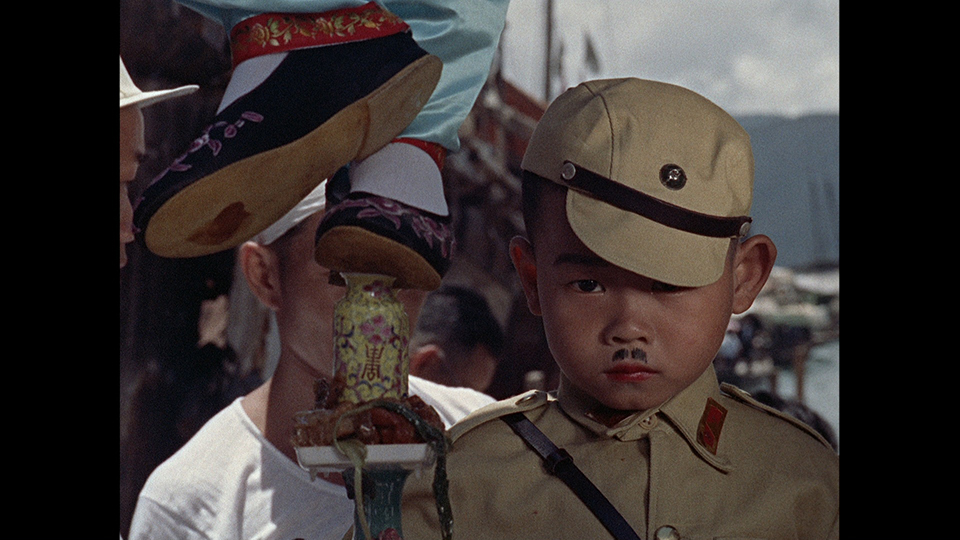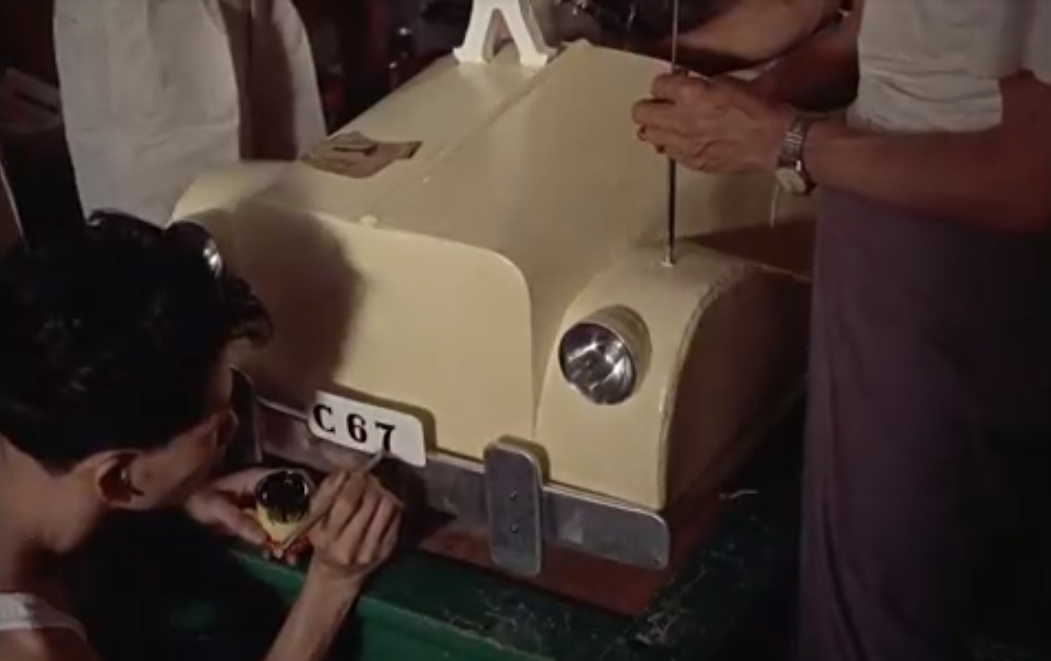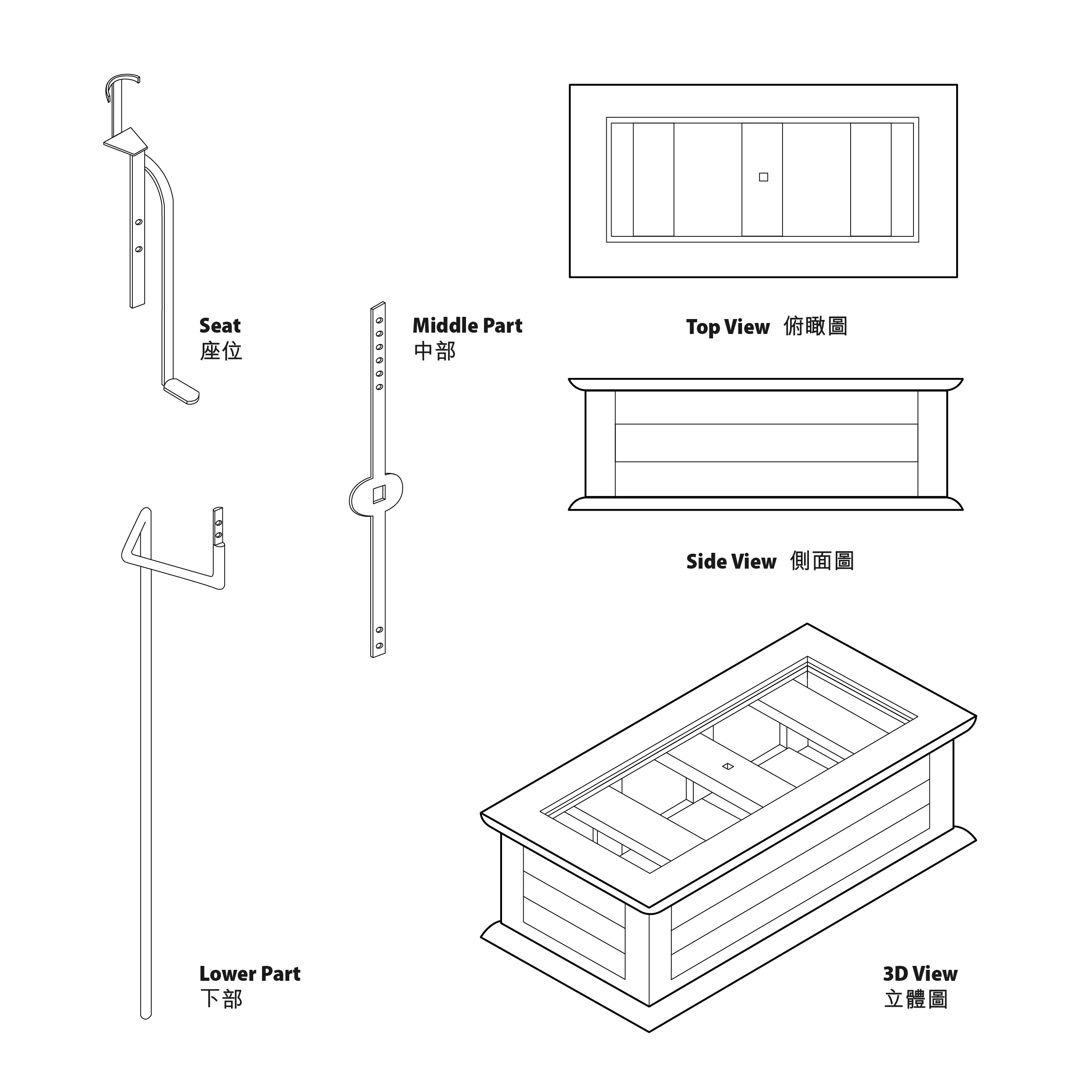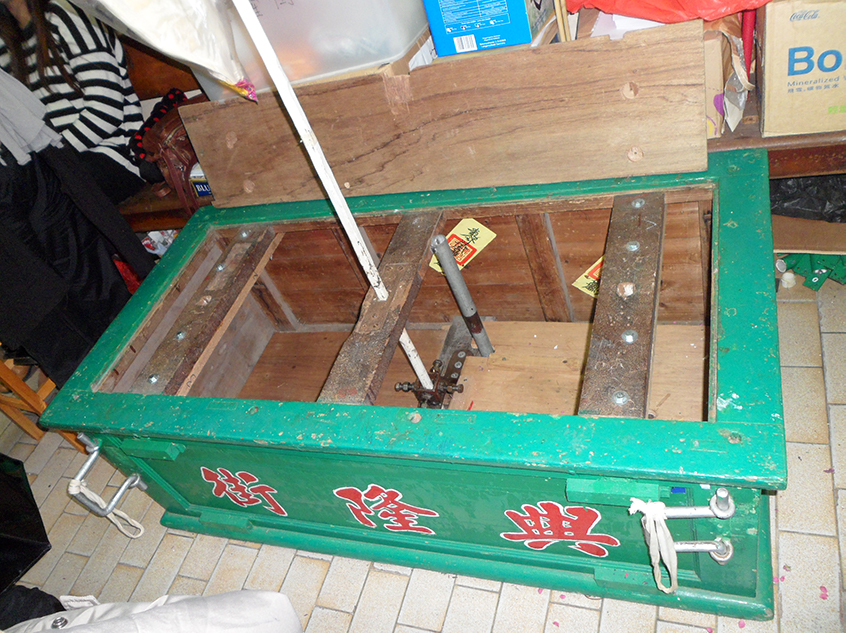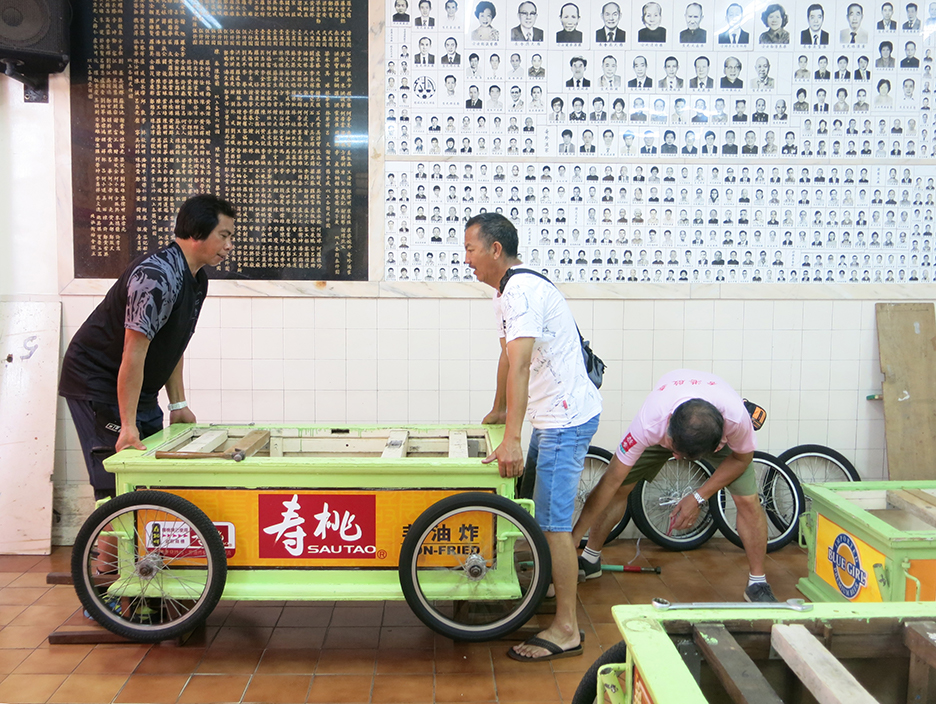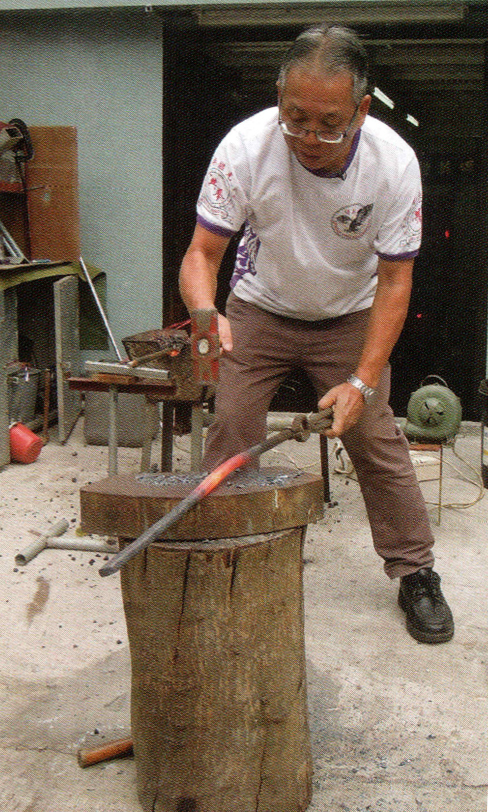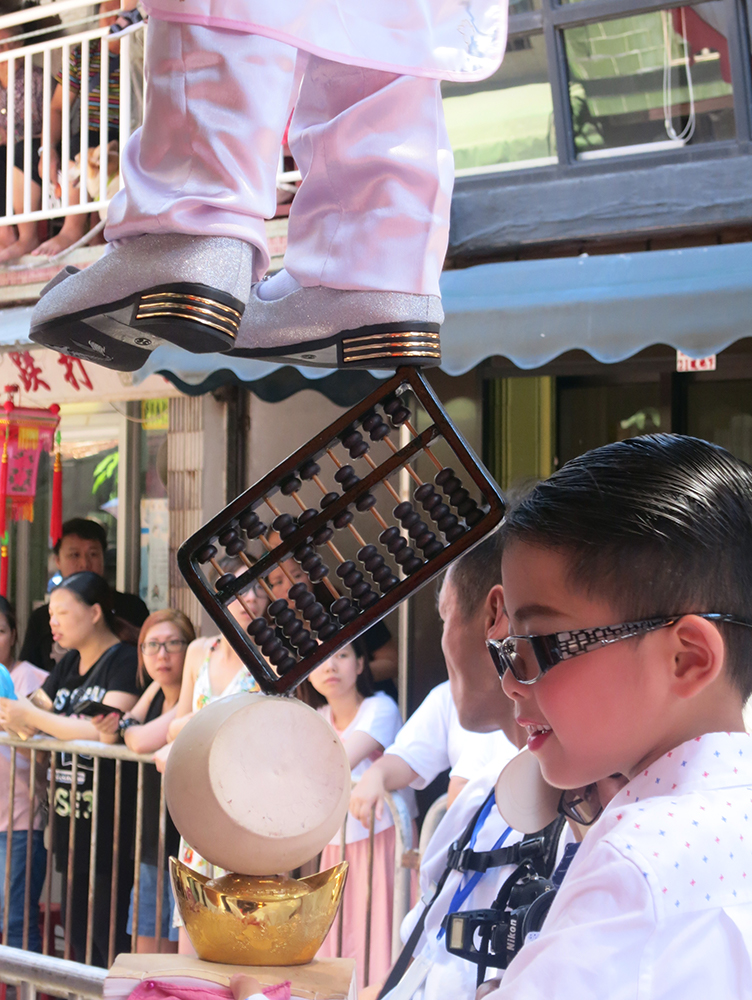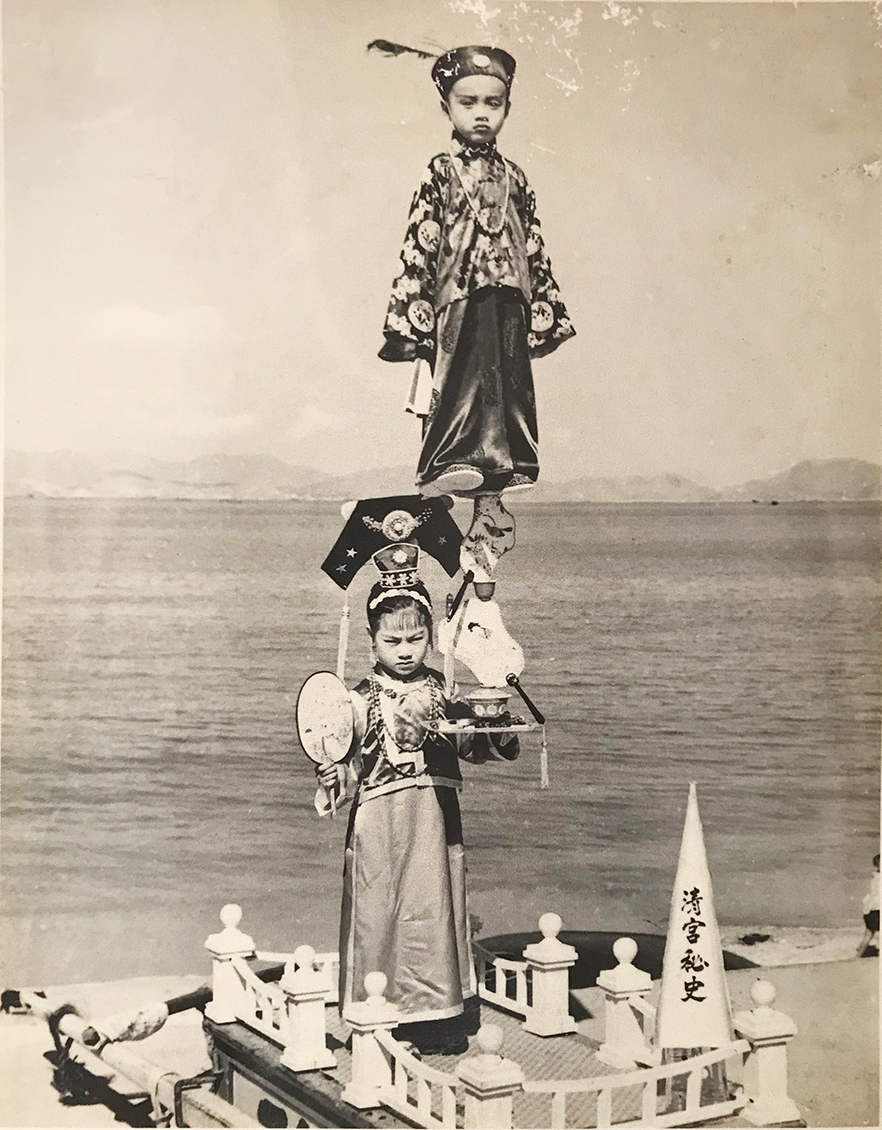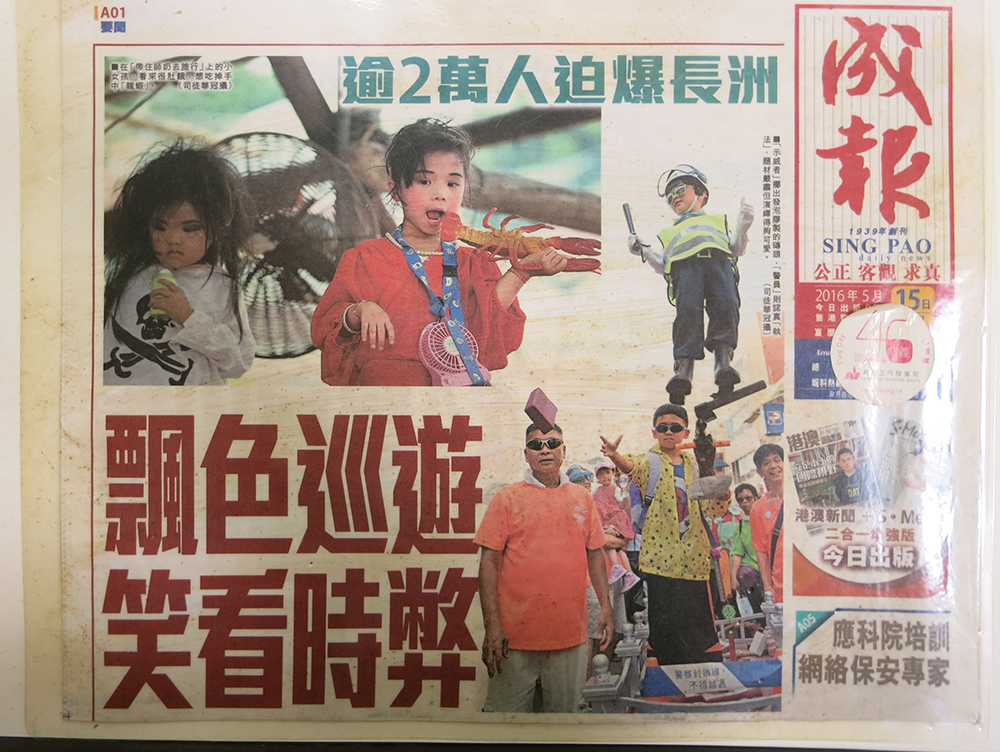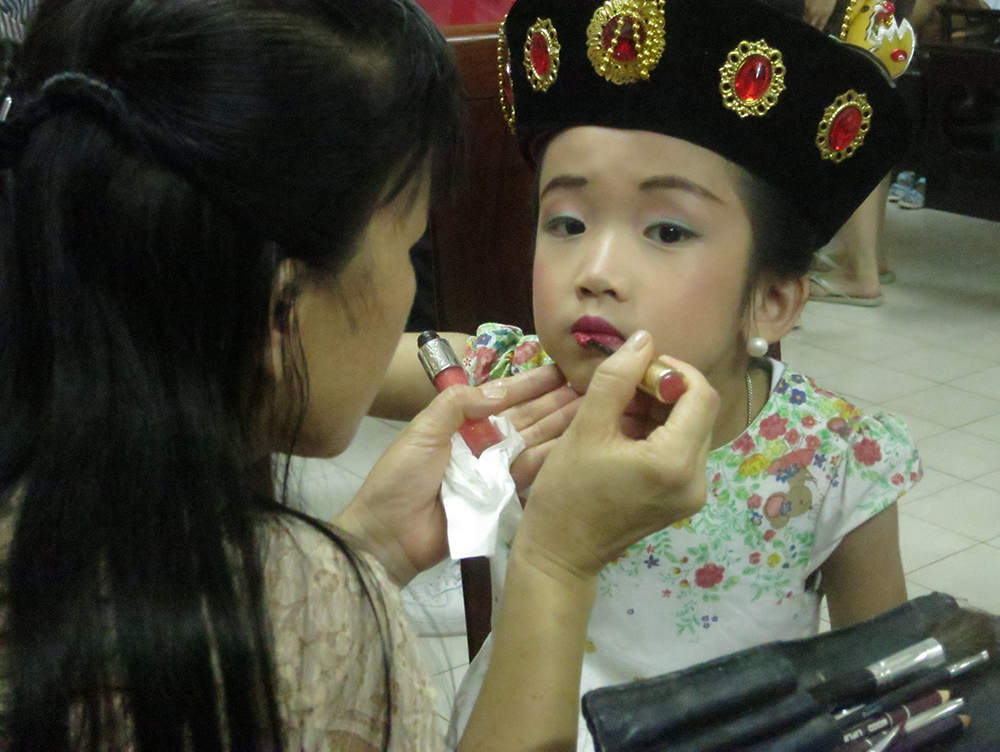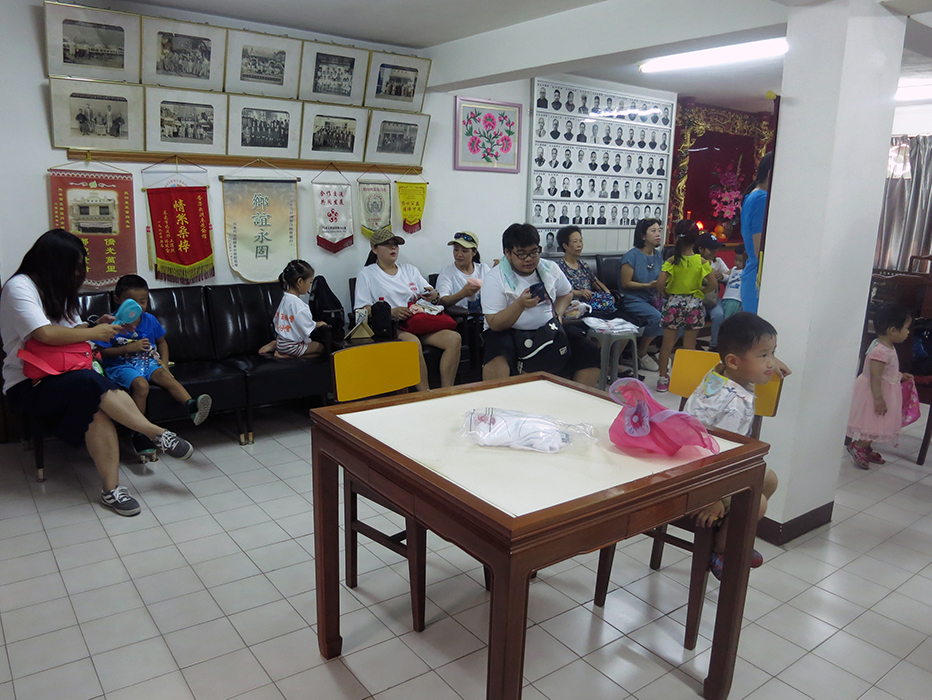CraftIntroductionIn 2012, Master AU Lay-wei of the Hing Lun Street Kai Fong Association conducted a Piu Sik production workshop at the Academy of Visual Arts, Hong Kong Baptist University. Most information in this research on the craft of Piu Sik is provided by Master Au. The documentary is an on-site video recording of an exhibition on traditional crafts titled Mastermind 2 organised by WooferTen, a Hong Kong community art and culture space. Piu Sik Parade was initially called “Zou Gu Shi”. It means that each Piu Sik set features a prominent character from tradition literature, opera repertory, or a well-known folklore as its theme. Nowadays, every street association in Cheung Chau generally produces two to four sets of Piu Sik themed on traditional and contemporary subjects. While a few groups feature either modern or classical themes, some feature both. Nevertheless, the one thing in common is that every group strives to attract audiences’ attention by adopting mesmerizing topics or stories. Since young people may not know traditional stories like “A Regretful Story in Tang Palace”, the romance story between Emperor Xuanzong of Tang and Yang Gui-fei, Piu Sik teams featuring these contents will woo them with the colourful ancient costumes. Also, because these teams handmade hundreds of exquisite ancient costumes in the past, they are inclined to reuse them to reduce the production cost whenever the topic and content of their new Piu Sik sets are relevant. The main focus of Piu Sik sets in contemporary theme lies in the satire towards current affairs as it can instantly gain recognition from the parade-goers and get to be the talking point. Sometimes, these sets can even make a pitch on the subject matter indirectly. Then, comics-themed Piu Sik set to appeal to teenage viewers through comic characters. On the day of the parade, different teams will present Piu Sik sets in any of these themes and costumes, distinguishing the Cheung Chau Piu Sik from the mainland’s variant as the latter only features Piu Sik sets on a single theme. There was once a foreign-produced documentary featuring the Piu Sik production and the parade of the Cheung Chau Bun Festival in 1960. The film began with the fishing village outlook of Cheung Chau, followed by the craft of Piu Sik production. As seen in the video, there were hovering kids impersonating Japanese soldiers, and the artisan in Hing Lun Street was building a Piu Sik set with a brand new car. Juxtaposing the brand new car and the painful memories from the war, the Piu Sik Parade presented an alternating time and space. (Figure 1, 2) "The theme and content of the Piu Sik have evolved with Hong Kong’s economic growth and the transformation of Cheung Chau’s environment. As Piu Sik masters boldly innovate and advance the craft, the Cheung Chau Piu Sik has become a testimony of Hong Kong’s history. For example, 'Olympic Spirit in 1984', 'Horse Racing Continue, Dancing Parties Go On' in 1985, and the 'Victory of Hong Kong Athletes in Seoul Asian Games' in 1986 gave lasting impressions to the parade-goers. And since the popularization of television in Hong Kong, well-liked TV series and characters have been appropriated as the theme of numerous Piu Sik sets. The reason is that they can win audience attention without a hitch and become a popular topic in small talks."1 Although traditional religious festivals are abundant in Hong Kong, the Cheung Chau Bun Festival is the most captivating event. And among the various ceremonies in the Bun Festival, the Piu Sik Parade is the most significant selling point. Through the masterful folk arts and crafts, ingenious disguising devices, engaging topics, and adorable hovering kids, the other-worldly Piu Sik "float" high, becoming one of the most permanent rituals among all religious activities in Hong Kong. For that reason, the media often visits Cheung Chau in advance of the annual parade to cover the related preparation works, especially the themes of the Piu Sik and the styling of the hovering kids of the year, as a reminder for the public and tourists to visit the island and enjoy the parade. Every year, the participating groups begin to prepare for the parade in the latter part of the first lunar month. The production of Piu Sik set is the most challenging part to process and complete for the whole preparation. It involves countless tricky tasks such as selecting the topic, modifying the mechanism, adding props as well as searching for the hovering kid. Even if all of these procedures are said and done, the parade teams still have to rehearse with the hovering kids in actual costumes so as to carry out necessary adjustments and further adaptations. Therefore, it is essential for each team to appoint an experienced master to lead a crew through the various phases of production. The crew also needs to meet frequently to review the production progress as well as to solve any unexpected issues. A "Piu Sik production crew" generally comprises four to five people. Each crewman is responsible for a different duty ranged from steel frame welding, props design, costumes, makeup to hairdressing. Some crewmen may work individually while some more complex tasks may require a few crewmen to complete together. In other words, a Piu Sik set is indeed a collective creation. (Figure 3) The absence of any draft or design layout throughout the production is also a unique quality to Piu Sik production. Instead, the craft depends on the accumulated experience of the Piu Sik masters since they make all adjustments and modifications through their professional judgments and physical touch. This unique quality, hence, requires the craft of Piu Sik to be "practised and passed on from person to person", qualifying it as an intangible cultural heritage. The Cheung Chau Bun Festival Parade involved thousands in the workforces to maintain good order, orchestrate the programme and document the event. The success of the parade lies in the active participation, collaboration and cooperation from the high cohesion community in Cheung Chau. The festival will not be able to unfold as systemically as it is without the support from the devoted, selfless islanders. Not unlike the production of a movie in which the director has to coordinate with the costume designers, props designers, sound engineers, screenwriters, cinematographers, film editors as well as the actors on screen to makes a good movie. The joyous and boisterous scene in the four-hour-long Cheung Chau Bun Festival Carnival Parade is the result of the cooperation and contribution of the immense manpower and resources from various groups and community members before and during the parade. The crewmen behind the scene are indispensable to the success of this annual festival. Themes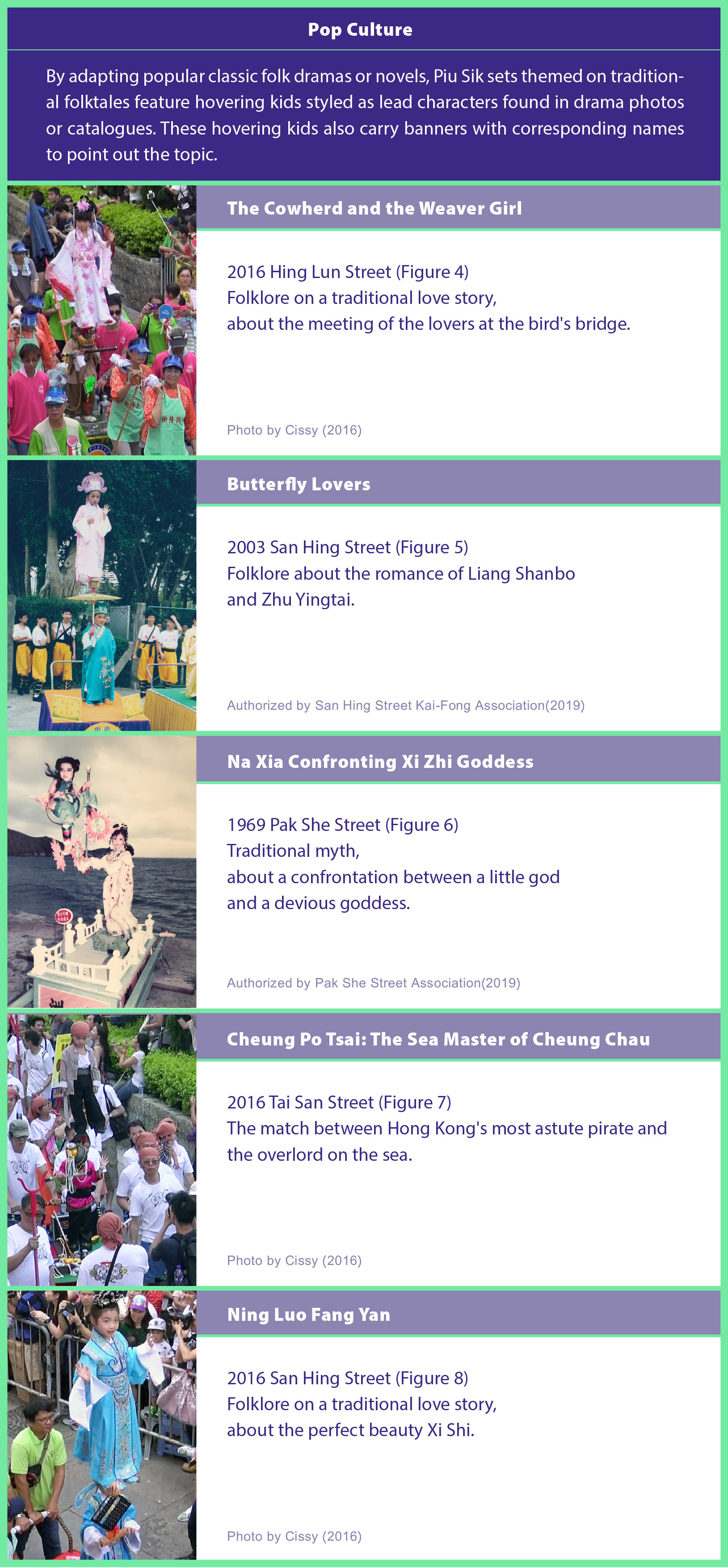 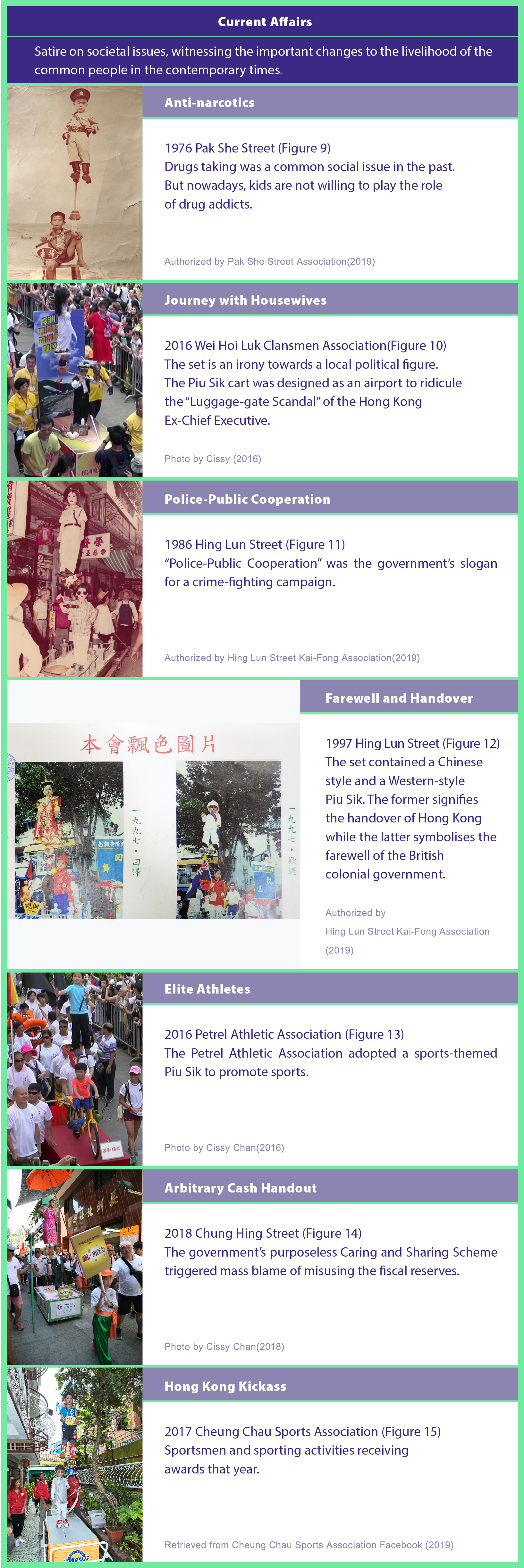 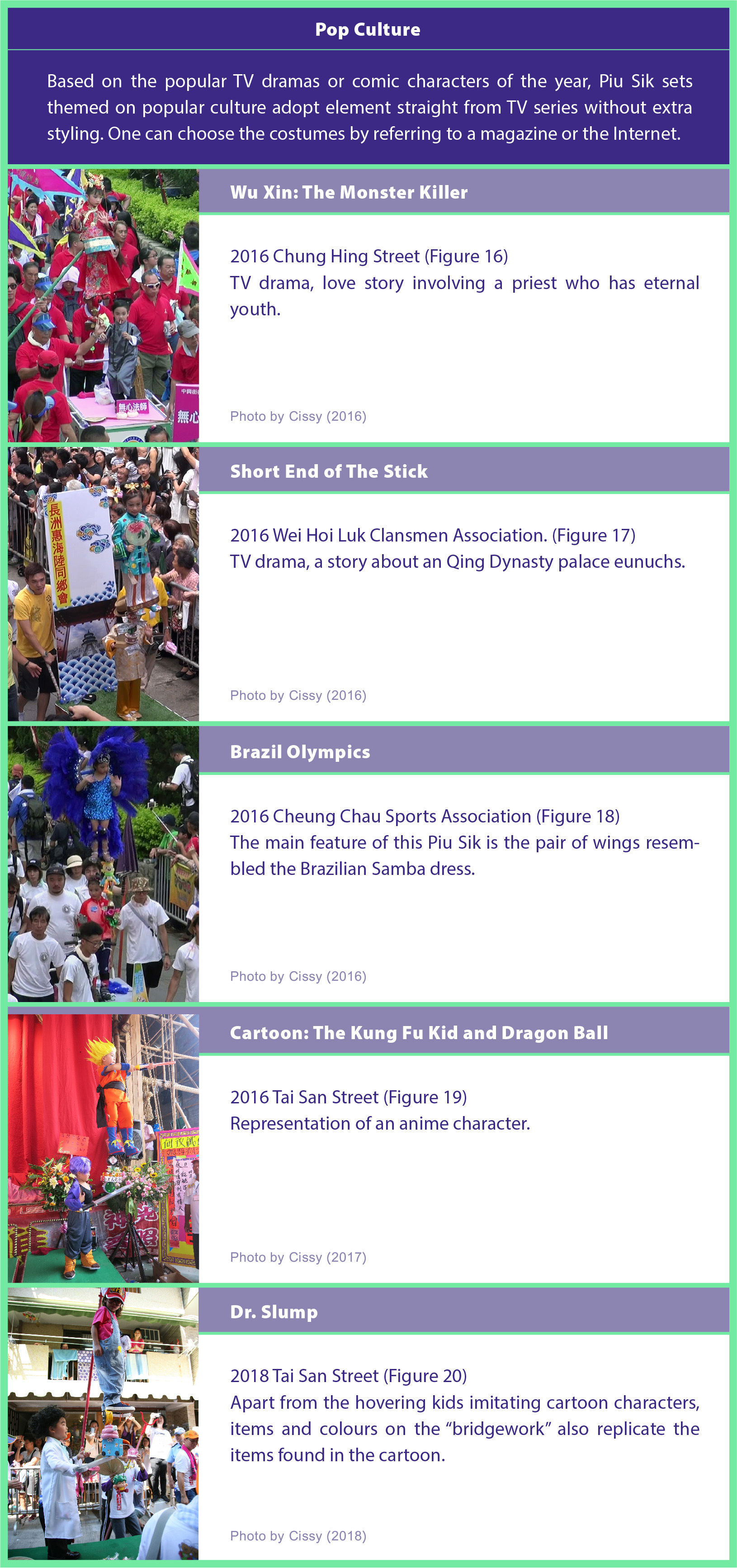 The StructureThe structure of a Piu Sik set comprises a cart and a steel frame. The installation of the steel frame on the cart requires specific fixing and welding techniques. One has to pay attention to the obliquity and balance of the cart as it towers after installing the frame. Also, the height of the set may cause difficulty in moving the cart out from the workshop for paint jobs. Then, hovering kids will be strained against the frame, (Figure 21, 22) and try on the costume days before the parade. In the morning of the ceremony, the hovering kids will be formally strained against the frame and partake in the four-hour-long parade. The whole Piu Sik production is only complete at this point. Piu Sik CartToday, most Piu Sik teams in Cheung Chau have adopted the hand-propelled Piu Sik cart. The Cheung Chau Hing Lung Street Kai Fong Committee is the only team that is still using hand-lifted Piu Sik cabinet. The size of the hand-lifted cabinet measures 29cm x 56cm x 19.5cm. (Figure 23) It takes two persons in the front and two persons at the backside to lift the Piu Sik. The parents of the hovering kids are responsible for holding an umbrella to shield the sunshine. They also carry a long stick to assist in balancing the hovering kids when going up and down slopes. By contrast, the hand-propelled carts used by other teams are relatively simple to operate. (Figure 24). Steel FrameThe steel frame in Piu Sik is a supporting structure attached to the Piu Sik cart. The thickness of the iron bars of the frame ranges from seven to ten centimetres. Various branches are welded onto the frame to join the substructures attaching the upper and lower hovering kids. The branches often penetrate through numerous props, giving a deceptive appearance that the upper substructure sits onto the props. Not only does this trick "conceal" the joints of the frame, but it also makes the top hovering kid look like standing in mid-air. Besides, the upper hovering kid will even "float" along with the movement of the Piu Sik cart. The measurement of the balance and centre of gravity are pivotal to the crafting of the steel frame in Piu Sik. Besides, the material and weight of props and the weight and height of hovering kids are all factors affecting the frame layout and installation. Master WONG Shing-chau, whose predecessors had worked as blacksmiths in Cheung Chau for three generations, has crafted numerous Piu Sik steel frames for the groups on the island. Even after his retirement, many groups are still using the pre-owned frames built by Master Wong. Sometimes, he will help to repair these old frames for reuse. Whenever Master Wong is modifying a used frame, he will first connect different parts by iron wire to measure the total length of the props and the two substructures. Master Wong will then adjust the height and size of the central pole and the branches according to the weight of the hovering kids. He will fix the steel frame only after the hovering kids have tried out the frame. Speaking of the craft of Piu Sik, Master Wong added, "Every group has its own set of requirements: some want the hovering kids on the left, and some want them on the right. They will usually provide me with a prototype built with armature wire as it is a rather convenient material for them to build the structure they want. I will then rebuild the prototype with iron bars. And because armature wire is elastic, it is impossible to directly replicate the prototype with iron bars. I have to make adjustments according to my experiences. Besides, apart from forging, blacksmiths like us are familiar with the strength of different irons. That is why it is necessary to have a blacksmith to build the Piu Sik frame as safety is always the first concern. Then, the selection of iron is also critical. Some irons contain impurities, and they will “bounce off” like wood. Regarding the heating of iron, it is not simply a matter of heating the iron red hot. Instead, it requires special techniques to control the temperature. Furthermore, hamming iron requires special techniques. It is impossible to explain all these skills easily. They are the accumulation of years of experiences and wisdom, and one has to apply different skills according to the actual situation. "2 (Figure 25) Hovering KidsUnlike the Foshan variant where multiple hovering kids stand on the top horizontal bar, only one hovering kid stands on the upper substructure in Cheung Chau Piu Sik due to safety concern and the narrow streets on the island. It is said that there are two types of hovering kids, namely the “Screen” and the “Float” in mainland China. Kids of different age and weight take up each of the roles. “Screen” refers to the kids that are sitting on the Piu Sik cabinet, and “Float” designates the kids that are standing on the upper position.3 The hovering kids on the top position (which are girls most of the time) are strained against a small iron plate installed on the central pole of the frame which the kids can lean on for keeping balance. And the hovering kids on the lower position (which are boys most of the time) sit directly on top of the Piu Sik cabinet. Hovering kids have to be four to seven years old children that weigh between 30 to 40 pounds and not taller than 42 inches. Kids that are too tall or too heavy will affect the load of the Piu Sik cabinet as the frame also has a limited resilience. Prior to the four-hour-long parade, the hovering kids have to remain on the frame for another hour for dressing and makeup. Therefore, it is quite likely that the hovering kids cannot stay calm over the five hours of preparation and parade. Also, the stifling heat in the season of the festival creates further discomfort the kids. Therefore, as a precaution against situations when the hovering kids are feeling unwell, most parade teams will recruit one or two extra hovering kids as backups. Hovering kids are usually recruited by the street associations or recommended by kai-fongs. Sometimes, the parade teams will even go to kindergartens to look for suitable kids and seek for the parents’ consent right away. However, due to the low birth rate in Cheung Chau in recent years and the parents’ reluctance to let their children undertake the exhausting duty, some parade teams have begun to recruit hovering kids from outside of the island through the social network of the kai-fongs. For that reason, many Piu Sik masters admit that searching for hovering kids is the most challenging task in Piu Sik production. On top of that, because the upper hovering kid, who impersonate the most eye-catching roles such as the emperor, princess, a celebrity or a policeman, is the central part of the Piu Sik. Most children would wish to take the role of the upper hovering kid. PropsOnce a Piu Sik master has decided on the theme of the Piu Sik set, he will begin selecting the most suitable old Piu Sik frame for the latest set. The master will then investigate how to craft and install new props to match the theme. The props installation, especially those on the so-called "bridgework" which connects the upper and lower substructure of the frame, is the quintessence of a Piu Sik set and demands the most technical skills. After choosing suitable props, the Piu Sik master will drill a hole, which matches the diameter of the frame bars, on each of them. He will then pierce the bars through the props, and weld the bars together. Because the joints are tiny, the installation thus gives viewers a false impression that the stacks of props are supporting the upper hovering kid. In the past, Piu Sik masters would look for props in Lascar Row or Sham Shui Po. Props like wine jugs were made of lead back then, and Piu Sik masters could only drill holes on them with simple hand tools. By contrast, wine jugs are made of porcelain nowadays, and plenty of types of machinery are available for drilling holes. There was once a set of Piu Sik that required a small motor to spin a prop. The master had no choice but to disassemble a tape recorder so to take the spinning wheel as the rotation mechanism for the Piu Sik. If a situation like this happens again now, one can head to Apliu Street to get hold of a small motor.4 Dynamic PropsThere was once a Piu Sik set installed with spinning props and a rotatable teapot. The trick for these props lies in the tiny motors mounted at the mid joint of the frame which turns the props attached to it like a revolving scenic lantern. Indeed, there are many more examples of spinning props in other Piu Sik sets. Hence, the spinning mechanism is undoubtedly a unique feature to Cheung Chau Piu Sik. Apart from the spinning props, living birds or chickens are also featured in various Piu Sik sets. The Cheung Chau Sports Association once used a ring to clasp a living pigeon on its Piu Sik set titled "The Farm Fun". They did this by fastening a string on the pigeon and cover it with the pigeon’s feather. As a result, the pigeon appeared to be standing on the Piu Sik. From the early days, Piu Sik sets have been imbued with spinning effects.(moving image 1) (moving image 1) Authorized by Getty Images (2019) Static PropsDespite most used props would never be used again, these props are still kept in storage waiting for opportunities of reuse. But nowadays, many props are readily purchasable from the Internet. Although the built quality of these props is relatively inferior, the low price that comes with single usage does minimize the Piu Sik production cost. Props are chosen according to their effectiveness in highlighting the topic of the Piu Sik set. Suitable props should conjure up the relevant theme upon first glimpse. If a Piu Sik set is based on a TV drama, the production team has to look for essential items associated with the story of the show. As for the props for the "bridgework", most of them contain symbolic meanings or implications. For example, the ingots in denote abundance, (Figure 26) while the Olympics symbol and trophies, (Figure 27) and the abacus and thousand-dollar banknotes (Figure 28) are both explicit symbolisms. In case of the found props do not fit with the Piu Sik frame, the production team will need work smart. For instance, if a suitable umbrella is not thick enough for the frame, the production team has to get an extra umbrella and join them together. Preparing a suitable frame would count on the flexibility and agile minds of the production team member. Combining a variety of readymade objects into one, a Piu Sik is analogous to a three-dimensional, mobile "installation" artwork. CostumesEvery group participating in the Piu Sik parade has decades of history. Therefore, they have inevitably preserved a significant amount of clothing and accessories in both ancient and modern styles. The ancient costumes are especially precious as they are no longer in production now. Once the theme of a Piu Sik is set, and the hovering kids are recruited, the costumes team will begin to search for appropriate clothing and accessories in the storage. Once suitable clothes are found, they will seek for help from female kai-fongs who are good at needlework or even professional tailors to adjust the size if necessary. The team will usually pick clothing in different colours for the upper and lower hovering kids. Nevertheless, bright and vivid colours clothes are always selected as they excel in winning attention. The costumes team will also deliberately pick oversized clothes and shoes so to reserve space for the Piu Sik frame. Mrs. Yeung has worked in the clothing industry for more than twenty years. She began to assist four street associations to source suitable costumes a few years ago. These street associations often provide Mrs. Yeung with images to exemplify their requirement. For example, if a hovering kid is to impersonate Mrs. Carrie Lam (Chief Executive of Hong Kong), the street association will provide pictures of the cheongsam and jacket they want. Mrs. Yeung will then follow the instruction to search for the clothing. As for the top, most are sourced by the Piu Sik production team. Only when the team cannot find the suitable clothing will Mrs. Yeung tailor it on demand. The same applies to headwear and hand ornaments. In general, the design and production of a Piu Sik set are done by the male members in these associations. They are excellent in crafting the structure and various mechanisms but are less attentive to the costumes, and accessories. By contrast, as Mrs. Yeung has worked in the field of wholesale clothing for twenty years, she has more sources to get hold of clothes. Therefore, it is for sure that Mrs. Yeung has a much easier time obtaining the clothes required. In theory, the content of a Piu Sik is rather confidential. Therefore, even after the decision on the theme was made by each street association, most members of a street association are not aware of what the other association are doing. Hence, Mrs. Yeung is the person who has the full picture of the topics of the four Piu Sik teams, and could work to ensure that the same clothing would not appear on the hovering kids from different organizations. Under such limitation, Mrs. Yeung can only try her best to meet the requirement of different groups.5 Ancient CostumesIn the early years, most ancient costumes in Piu Sik sets were derived from the styling of the protagonists in Cantonese Operas. These costumes were tailor-made to kid’s size in Guangzhou in conformity to the specification of the Cantonese Opera costumes. Hence, the cost of embroideries and silver threads were high. In addition, Piu Sik masters had to travel to the embroidery workshops of Cantonese Opera troupes in Guangzhou to moderate the costume production. The travel expenses further escalate the production cost. The Jinghua Embroidery in Hong Kong had also produced some ancient costumes. Take the Piu Sik set themed on the "Legend of the White Snake" as an example, the outfit of Xu Xian is needed to match with the white snake and the costume of the monk is required to pair with the green snake. Because ancient costumes take reference from the styling in Cantonese Opera, the dresses have to follow the traditions of the specific historical period. For that reason, only a small number of alterations can apply to ancient costumes. For example, the dresses for the concubines to the Qing Emperors must be grand and glamorous. (Figure 29)Then, since the steel frame is affixed to the centre axis of the costume, and the substructure extends towards the two sleeves of the top, the sleeves have to be wider than usual, or the hovering kid will not fit in the clothes. As a result, all ready-made clothes have to be modified, and shoes should also be two or three sizes bigger so to make space for the Piu Sik frame. The male and female members in a Piu Sik production team are in charge of different duties. Female team members are responsible for sourcing clothing matching clothes, headwear and accessories, search for online information and costume design and colours scheme. The masters, who are mostly male, are responsible for making the final decisions. Nonetheless, the masters generally agree with that the female members' aesthetics and adopt their opinions. Modern ClothingAs modern clothing can be found and purchased online, Piu Sik production teams only need to buy slightly larger clothes for further modification. The only drawback of buying clothes from the Internet is inferior fabric quality. Since the costume design team of in Piu Sik sets themed on current affairs can refer to the posture and clothing style of the public figures to be featured, it is much more straightforward for them to represent the appearance of the characters. This kind of Piu Sik is regarded as successful as long as the audiences can discern the figure. As for satirical Piu Sik sets, the props should be able to denote the relevant event. The police uniform and demonstrators’ clothing, and props such as fists, stones, and the banner written with "Police Cordon. Do Not Cross" are some of the excellent examples that accentuate the theme of a Piu Sik set. There was once a Piu Sik set featuring a political figure’s wife who was often mocked as a “lobster” for her grotesque red dress. The Piu Sik team, hence, succeeded in winning the media coverage by dressing the hovering kid in bright red clothing and placing a lobster in her hand.6 (Figure 30) Then, for Piu Sik sets referring to the characters of the comics, the costumes and styling are relatively simple as comic characters are fictional with only a single, consistent appearance. Therefore, this kind of Piu Sik is very much like a cosplay in which the hovering kids will dress up as comics characters. As long as the hovering kids are adorable, and their gestures are dynamic, the Piu Sik set should be capable of bringing interactions at the scene. Besides, the hovering kids of this sort of Piu Sik can also throw souvenirs to the audiences to further heat up the joyous and cheerful atmosphere. (Figure 31) MakeupThe makeup for the hovering kids is usually done inside the site of a street association or a nearby space rented out by an affiliated group as these venues are generally more spacious. Generally, two to three female kai-fongs are in charge of the makeup duty of a parade team. Nevertheless, professional makeup artists are invited for the job on some occasions. A few costume designers will also take up the makeup duty. But anyhow, the makeup artists will decide on the make up in relation to the roles of the hovering kids. For example, a thicker makeup will be applied to highlight the facial features of the girls impersonating ancient character as they usually stand on the higher position of the Piu Sik. (Figure 32) By contrast, makeup will be applied to the boys enacting opera characters in the lower position to highlight their charm and smart complexion, though the traditional "lifting eye" makeup is not adopted. In comparison, hovering kids in Piu Sik sets themed on modern subjects generally wear simpler makeup. Nevertheless, their makeup still gravitates towards the heavier approach depending on the role play and the characters they imitate. In the morning of the parade day, the hovering kids will receive makeup service, hairdressing session, and they will put on headwear and costume in sequence. But if a makeup artist is responsible for the makeup of several groups, she will have to ponder on the makeup that match and give prominence to the theme of each Piu Sik set long before the parade day. On the parade day, parents will bring their kids to the dressing room and wait patiently for the makeup service. Other female kai-fongs, as well as the people who have moved away from Cheung Chau, will all come to lend a helping hand. They will work like production assistants in a filming studio, diligently helping the hovering kids (Figure 33) to put on the costumes or lead them to the corresponding Piu Sik cabinet. The Piu Sik master will then take over and bind the hovering kids against the Piu Sik frame. 1 Rabbito. (14 Aug, 2018) 3.2〔Hong Kong Cheung Chau Bun Festival Piu Sik Parade﹞飄色會景巡遊. 〔An Investigation on the Change of Local Traditional Taoist Ritual in the Modern Society through the Origin and Development of the Cheung Chau Bun Festival﹞從長洲太平清醮的源流及發展探討本土傳統道教儀式在現代社會的變遷. Retrieved from http://daimones.blogspot.com/2007/05/rabbito.html 2 Master Wong Shing-chau (personal communication, April 15, 2016) 3 WANG Wei-nuo (Ed) (2007) The Stage in Air : Guangdong Piaose Art. (pp.5) Harbin: Heilongjiang People's publishing House. 4 Master CHEUNG Chik-fan (personal communication, May 12, 2016) 5 Mrs. YEUNG (personal communication, May 12, 2018) 6 Sze Tao Wah- kwan (May 15, 2016) Piu Sik Parade, Satire on Contemporary Problems. Cover story of Sing Pao. |

